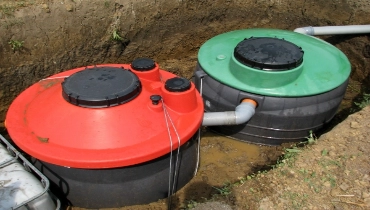
Mr. Rooter Plumbing explains the main types of septic tanks and systems for homeowners.
|
Septic tanks may seem pretty one-size-fits-all, but there are a few varieties you can choose from for waste management. Learn more about the benefits and limitations of each system so you can make the best choice for your home.
What Type of Septic System Do I Need?
The septic system that’s right for you depends on your available space, where you live, and what your needs are. Every system has pros and cons, and each is best suited for a different environment.
- Conventional septic system. The traditional layout of an older standard septic system is a decentralized system that runs through a drain field. The drain field is made of gravel or stone and filters liquid waste so it can run safely into the ground. It’s good for residential homes or small businesses, but it has a large footprint that can limit placement.
- Chamber septic system. When it comes to a chamber septic system vs. a conventional one, the main difference is that a chamber system doesn’t filter through stone or gravel. Instead, the filters are manufactured with a series of plastic chambers filled with soil. A chamber system is useful if the amount of wastewater varies throughout the year (like at a vacation home). They’re also good for homes with high groundwater tables or if plastic chambers are easier to get in your area than gravel. It’s easier to deliver and build chamber systems, but they also take up a lot of space in the ground.
- Drip distribution septic system. Drip distribution systems work by releasing pretreated, timed deliveries of wastewater. Because waste is released in such small amounts, it can be treated more thoroughly before going back into the soil. Drip distribution tubing is usually buried only 6-12 inches below the surface, so you don’t need a large mound of dirt to cover it. However, it does require the installation of a large dosage tank after your septic tank and requires electricity to run.
Related Topic: How Do I Keep My Septic System Healthy?
What Is an Alternative Septic System?
Alternative septic systems are nonstandard or unusual options for waste management that often work better for unconventional areas. If waste management is giving you problems and you can’t address your septic issues on your own, a range of alternative septic systems is available:
- Raised bed/mound septic systems. A high-water table (groundwater close to the surface) can make placing a septic tank difficult. Building partially above ground with a mound of dirt allows you to place a septic system without harming the water table.
- Aerobic treatment systems. This system uses more air and oxygen in its sewage treatment process. It’s ideal for single homes or a small group of homes, and it produces higher-quality wastewater that can be distributed over a smaller leach field.
- Waterless systems. If you’ve ever used a compost bin, a dry septic system works similarly. You can choose to drop waste into a collection bin below or outside your home for composting or get an incineration system to burn waste. Waterless systems are smaller and more eco-friendly than other septic systems.
Get Help Choosing the Right Septic Tank System
Choosing the right septic tank and system for your home doesn’t have to be difficult. If you need help deciding what system will work best for your property, contact your local Mr. Rooter. We can review different options, and help you select the right septic system for your home. We can also ensure it is properly installed and set you up with a maintenance plan that will keep your systems operating efficiently all year long. To get started give us a call or request an estimate online.

